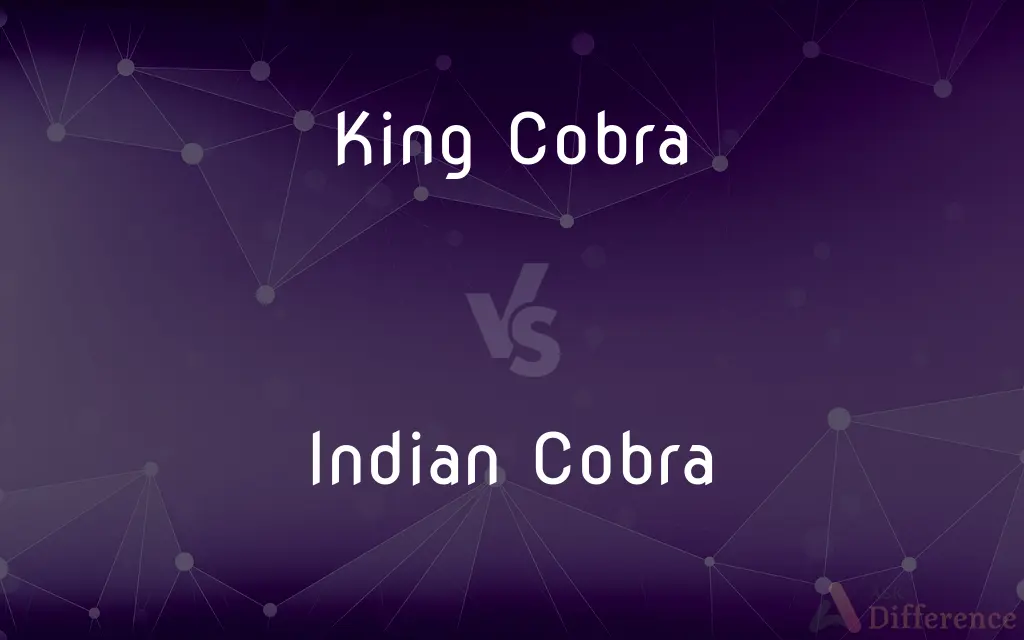King Cobra vs. Indian Cobra — What's the Difference?
Edited by Tayyaba Rehman — By Fiza Rafique — Published on December 11, 2023
The King Cobra is the world's longest venomous snake, primarily preys on other snakes, and is native to forests in Southeast Asia, while the Indian Cobra is shorter, recognized by its hood marks, and found mainly in the Indian subcontinent.

Difference Between King Cobra and Indian Cobra
Table of Contents
ADVERTISEMENT
Key Differences
The King Cobra is distinctively known as the world's longest venomous snake, reaching lengths of up to 18 feet. In contrast, the Indian Cobra is substantially shorter, often measuring between 4 to 7 feet.
The primary diet of the King Cobra revolves around other snakes, earning it the moniker "king" as it can even feed on other venomous snakes. On the other hand, the Indian Cobra has a varied diet that includes small mammals, birds, and reptiles.
Native to the rainforests and plains of Southeast Asia, the King Cobra is found in countries like India, China, and Indonesia. The Indian Cobra, as its name suggests, predominantly resides in the Indian subcontinent, though its range extends to some neighboring countries.
One of the signature features of the Indian Cobra is the hood mark, often resembling eyes or a spectacles pattern, making it synonymous with snake charmer displays. While the King Cobra also has a hood, it lacks such distinctive markings.
When it comes to venom, the King Cobra possesses a powerful neurotoxic venom that can be fatal to humans if not treated promptly. The Indian Cobra too carries a potent mix of neurotoxins, but its venom yield and effects differ from that of the King Cobra.
ADVERTISEMENT
Comparison Chart
Size
World's longest venomous snake, up to 18 feet
Typically 4 to 7 feet long
Diet
Primarily other snakes
Small mammals, birds, reptiles
Range
Southeast Asia, including parts of India
Predominantly Indian subcontinent
Hood Markings
Lacks distinctive hood marks
Often has a spectacles pattern
Venom
Powerful neurotoxic venom
Mix of neurotoxins, varies in effects
Compare with Definitions
King Cobra
A snake often associated with cultural reverence in some Southeast Asian regions.
In certain cultures, the King Cobra is seen as a symbol of power and grace.
Indian Cobra
A snake with a varied diet that includes small mammals, birds, and reptiles.
We watched the Indian Cobra hunt a rat in the grassy patch.
King Cobra
A large venomous snake known for being the longest of its kind in the world.
The King Cobra can reach lengths of up to 18 feet.
Indian Cobra
A reptile known for its potent mix of neurotoxins in its venom.
Victims of an Indian Cobra bite must seek immediate medical attention to counteract the venom.
King Cobra
A reptile native to Southeast Asia, with a primary diet of other snakes.
The King Cobra's prowess as a snake-eater earns it the title of king.
Indian Cobra
A species that is often synonymous with myths, legends, and religious significance in India.
In many Indian myths, the Indian Cobra is seen as a protector or a symbol of fertility.
King Cobra
A snake species which, when threatened, raises its body off the ground and expands its hood.
During our trek, we encountered a King Cobra displaying its hood in a defensive stance.
Indian Cobra
A snake that, when threatened or agitated, displays its hood and hisses as a warning.
On our village tour, we saw an Indian Cobra spread its hood, warning the onlookers to maintain distance.
King Cobra
A snake renowned for its distinctive hood and potent neurotoxic venom.
Villagers were cautious as they had spotted a King Cobra near the water source.
Indian Cobra
A venomous snake recognized by its hood marks, native to the Indian subcontinent.
The Indian Cobra's distinctive hood markings are often seen in traditional snake charmer performances.
Common Curiosities
Where can you primarily find the Indian Cobra?
The Indian Cobra is predominantly found in the Indian subcontinent.
Is the venom of the Indian Cobra fatal?
Yes, the venom of the Indian Cobra can be fatal if not treated promptly.
Do both King Cobra and Indian Cobra have hoods?
Yes, both snakes have hoods, but the Indian Cobra has distinctive markings on its hood.
How does the King Cobra's venom compare to the Indian Cobra's?
Both possess neurotoxic venom, but the King Cobra's venom is particularly powerful and can be lethal in smaller amounts.
Which snake primarily feeds on other snakes?
The King Cobra is known to primarily feed on other snakes, including venomous ones.
What is the significance of the hood marks on an Indian Cobra?
The hood marks, often resembling spectacles, make the Indian Cobra easily identifiable and culturally significant.
How do King Cobras and Indian Cobras react when threatened?
Both species will raise and spread their hoods when threatened, with the King Cobra also being known to emit a hiss.
What is the King Cobra best known for?
The King Cobra is best known as the world's longest venomous snake.
Is the King Cobra a type of cobra or a separate species?
The King Cobra is a separate species and is not considered a "typical" cobra.
Are both King Cobra and Indian Cobra found in India?
Yes, both species are found in India, but the King Cobra also has a wider range in Southeast Asia.
How large can the Indian Cobra get?
Indian Cobras can grow to lengths of 4 to 7 feet.
Is the Indian Cobra synonymous with snake charmer displays?
Yes, the Indian Cobra is often seen in traditional snake charmer performances due to its distinctive hood markings.
Are there cultural or religious significances associated with the King Cobra?
Yes, in some Southeast Asian cultures, the King Cobra holds religious reverence and cultural significance.
How can you differentiate between a King Cobra and an Indian Cobra in the wild?
*Notable differences include size (King Cobras are much longer), diet, hood markings (present in the Indian Cobra), and geographical
Do both King Cobra and Indian Cobra come in different colors or patterns?
Both snakes can exhibit variations in color and pattern, but the Indian Cobra's hood markings are its most distinctive trait.
Share Your Discovery

Previous Comparison
PayPal Business vs. PayPal Friends and Family
Next Comparison
Commercial Banks vs. Cooperative BanksAuthor Spotlight
Written by
Fiza RafiqueFiza Rafique is a skilled content writer at AskDifference.com, where she meticulously refines and enhances written pieces. Drawing from her vast editorial expertise, Fiza ensures clarity, accuracy, and precision in every article. Passionate about language, she continually seeks to elevate the quality of content for readers worldwide.
Edited by
Tayyaba RehmanTayyaba Rehman is a distinguished writer, currently serving as a primary contributor to askdifference.com. As a researcher in semantics and etymology, Tayyaba's passion for the complexity of languages and their distinctions has found a perfect home on the platform. Tayyaba delves into the intricacies of language, distinguishing between commonly confused words and phrases, thereby providing clarity for readers worldwide.














































